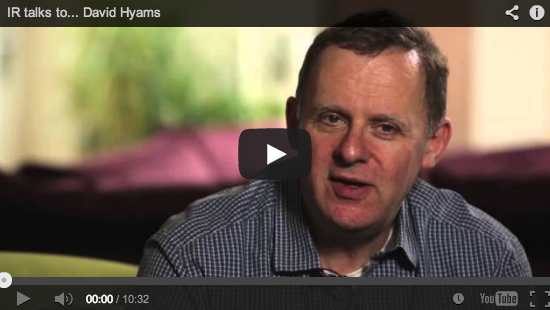There’s a lot of noise surrounding integrated print these days. While still in its infancy, it shows signs of rapid growth. And there are those already making a very decent living out of it; David Hyams is one of them. Having run his own graphic design business for 20 years before getting involved in digital print, he then co-founded Talking Print in 2011, a company that provides audio and video implanted print services. To describe him as ‘enthusiastic’ about the potential for such products is something of an understatement…
IR: David, you’re a designer by trade but also an evangelist for ‘integrated technologies’ in relation to digital print. How’s that come about?
Yes, well I originally trained as a graphic designer and had my own graphic design business for years. I then discovered digital print and became director of a digital print company back in 2000 when digital technologies were just taking off. I was brought in to show off what wonderful things you could do with digital print and take the print industry into a different area. My role was to talk to marketers about interesting stuff they could do with print.
In 2011 you set-up Talking Print as a link between printers and Internet developers to create dynamic marketing applications and products. Can you explain your rationale behind the operation?
When I worked at the digital print company we worked across a variety of markets and technologies including wide-format. These technologies could do very creative things: short-run, personalised materials and offering marketers new ways of working. But I thought we could add more and give printers an extra tool. So, rather than just produce print, why not add audio, why not add video?
So I then joined up with an expert in sourcing audio and video components in the Far East and we put together Talking Print to give printer, marketers and creatives something extra.
Talking Print provides audio and video embedded promotional print products but I understand it doesn’t actually do any of it’s own printing. Is that right, and do you therefore have specific print ‘partners’?
We act as a consultancy, so we really start with an idea. The printers, or the marketers, or the creatives have a blank piece of paper and say ‘wouldn’t it be great if we could add light, or sound, or video’ – and up to now they haven’t had a clue how to do it. So, what happens is people go onto Google and type in ‘audio module’ or ‘video’ and guess what, we come up because we’re the people who are doing this.
Obviously, to deliver the end product we have to work with sound/video module suppliers and print partners. We don’t actually own any printing equipment.
How it works, is we talk to people who have the ideas and put together a solution for them. We put together samples for them to show what can be achieved so the creative can present to their client to get the idea signed off. To produce the end product we have a pool of printers in the UK.
The important thing to bear in mind is that the process is controlled in the UK. Many people don’t want to deal with China and vice versa. We act as a conduit and take the pain out of that – and can turn around samples very quickly. Until now, people have had to try and deal with China directly for components and it’s a long-winded process.
How can other (large-format) print companies buy-in to your audio and video embedding technology, services, know-how?
If we are working with a printer they obviously want to do the print here in the UK. So a printer may have had a discussion with a client/creative who’s asked if they can do a job including embedded sound or video and they come to us and we will sit down and discuss the options with them.
We do not put our name on products, so we will work with whoever, to provide a solution to the brief. Having come from a creative background I can talk the language of the creative so they understand the solutions, but also, with my print background, I can talk to the printer and say ‘yes, you can do it this way or that way…’ and I understand the restrictions with the different technologies.
What kind of customers come to you and how much knowledge do they have of integrated print?
Because we’re still quite new most of the people who come to us do so because they are the ones who actually have an idea about how to use embedded technologies and they don’t know whether it can be done or not. A lot of people say ‘thank god I found you’ because they’ve had what they think is a great idea and just don’t know how to go about making it reality. Inevitably, people have these ideas then search on the Internet for ‘audio module’ or whatever as I mentioned before, and that’s how they find us.
What role do you think print providers have in progressing the demand for ‘integrated print?
Part of the basis of what we’re doing is we feel we’re giving printers something new to sell to their clients. Having come from printing I know print is changing – the long run jobs don’t exist anymore, or are very few. So what we’re providing is a tool for printers to go to a customer and say ‘instead of just a poster why don’t you put a sound module in it or a video clip’.
I appreciate that printers don’t perhaps know how to go about getting this stuff produced, which is where we come in. We’ve taken away the headache of sourcing sound and video components from China so we can produce samples etc. over here. We source the actual modules on your behalf so you just do the print. It’s about us trouble shooting on that front for you so an end product can be delivered to and end client.
How key do you think it is that (large-format) printers go to events like ‘Technology for Marketing and Advertising’ where you exhibited this past February?
I think it’s very important. Because I come from a marketing background and then got into print and then into the Internet and everything that surrounds it, I didn’t sit in a bubble and just focus on one thing. And I think it’s crucial that printers get out there and learn about other technologies and talk to people about how they can use them. When I first started I found it very odd that printers would not talk to Internet developers and vice versa, and that’s really where I came in. I saw myself as a kind of evangelist on combining print with all the new technology that’s out there.
You say the most exciting part of bringing your integrated print products to market, has been working with creatives to explore the opportunities to enhance the printed medium. How open are they to the discussion – and how strong a feeling do you get that this integrated approach will breath longer life into print?
I love it when I sit down with creative, because their mouths drop open when they realise what you can do. Integrated technologies just opens up a whole new world for them and they get really excited. I just tell them it’s a blank piece of paper; you can put a button on your print and make it sing, or you can put a video on it and make it talk. It’s really up to them to come up with an idea and we’ll help them produce wonderful stuff.
An edited version of this interview can be seen as a video.
{jathumbnail off}



